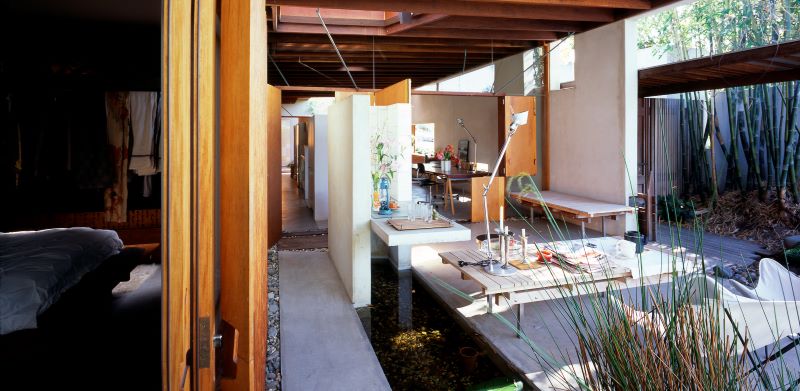By Jessica Yule
Many of you may have walked past this house but I would guess that few knew what architectural delights were hiding behind the front door…
Introducing the D House, which was designed by Donovan Hill, revered Brisbane architecture firm, and completed in 2000 for their client and friend, Geraldine Cleary.
Situated at 215A Harcourt Street, this unassuming gem of contemporary architecture is well known and highly regarded within the architecture and design communities and has been widely published.
A consciously modest project, this is a house behind a garden wall. It is small yet feels perfectly and elegantly proportioned when you’re inside. There is a deliberate play on scale, recognised in details such as the sizes of the openings, heights of walls and sizes of passageways. For example, the doors to the private rooms (such as bedrooms) are unusually narrow, particularly in comparison with the large wall-like pivot doors at either end of the main room.

Photo Credit: John Linkins
One of the most interesting and experiential parts of the house is the elongated entry path and the connection between the street (public domain) and the private dwelling. A generously large window sits adjacent to the path to the front door and sets up a relationship between footpath and private space. In the same way people at a café might be drawn towards sitting at the window to partake in people-watching, this house plays on a similar concept. (In fact, the house was designed to be able to accommodate many other uses besides a private residence – café, office, gallery, the options are endless!) However, one never feels too exposed in this room as there is still a level of privacy achieved through the use of a sliding timber screen with spaced, angled blades that adjust to completely close off views from passers-by looking in, while still allowing occupants to look out. A grove of Tuckeroos, planted in the private frontage and whose foliage has become very dense, adds another level of privacy, as well as climate control and shade.

Photo Credit: John Linkins
This main room is actually the largest space in the house. It is known by the architects and the owner as the “public room”. It’s small enough to not feel empty when just occupied by one, but not too crowded when the owner hosts events or parties. Helping to make this possible are two “outdoor rooms”, which sit at either end and contribute to making the whole space feel like one continuous indoor/outdoor room. In the centre sits a beautiful suspended timber and leather sofa that also houses the owner’s favourite artwork on a ledge behind it.

A ¾ height wall partitions off the kitchen from the public room and reflects light into it. A sense of intimacy and separation is achieved through the use of the angled entry into the kitchen and interestingly, the small and utilitarian layout of the cooking space feels just right. This kitchen space is part of what could be considered a service arcade, or passageway, from which you find the 2 bedrooms, bathroom and laundry, the most private spaces in the home.

Photo Credit: Jared Fowler
The house succeeds in blurring boundaries between “inside” and “outside” in a very considered manner. Full height glass at either end of the main room allows light from the top of the wall to illuminate the floor and walls of inside spaces. Interior and exterior floor levels are exactly the same which makes the indoor and outdoor spaces seem equivalent (this is made possible due to an interesting drainage strategy which allows water to flow off the courtyard floor and overflow from the pond to recessed drains). “Outside-like” materials are extended into inside spaces and vice-versa, such as the use of pebbles and pavers placed at thresholds, resulting in a feeling of walking through a garden all the while being inside your home. It’s a real delight of the senses! Due to the high garden walls blocking winds, even the outdoor courtyards can be furnished with items one would normally associate with the indoors, such as books, cushions and vases of flowers (unless there is a cyclone brewing up from the North-East).

Photo Credit: John Linkins
One of the most beautiful design outcomes would have to be the way the interior surfaces reflect light, making comfort without the need for curtaining.
Upon engaging Donovan Hill, Geraldine’s focus was on creating ‘a quality building – a flexible and enjoyable environment for me and others who might live here in the future’. She enjoys sharing her house with guests and frequently offers up the public room as a venue for friends to host events.*
The D House was awarded Australia’s most prestigious residential architecture prize, the Robin Boyd Award in 2001. What a brilliant example of contemporary Australian architecture at its best!
Jessica Yule
*From time to time, in Autumn and Spring, Geraldine opens the house for tours of 6-20 people at a small cost. Please contact her via email if interested: gcleary6@gmail.com.

Photo Credit: Jared Fowler
Images courtesy of Partners Hill Architects.
If you would like to know more, here are some resources for further reading:

